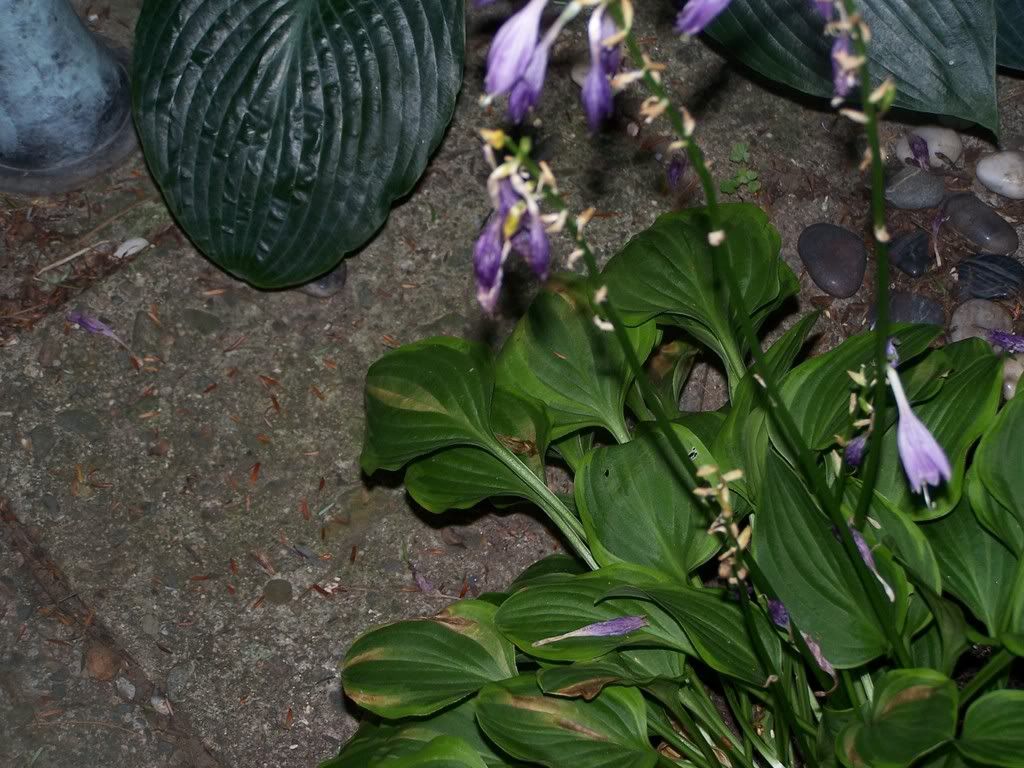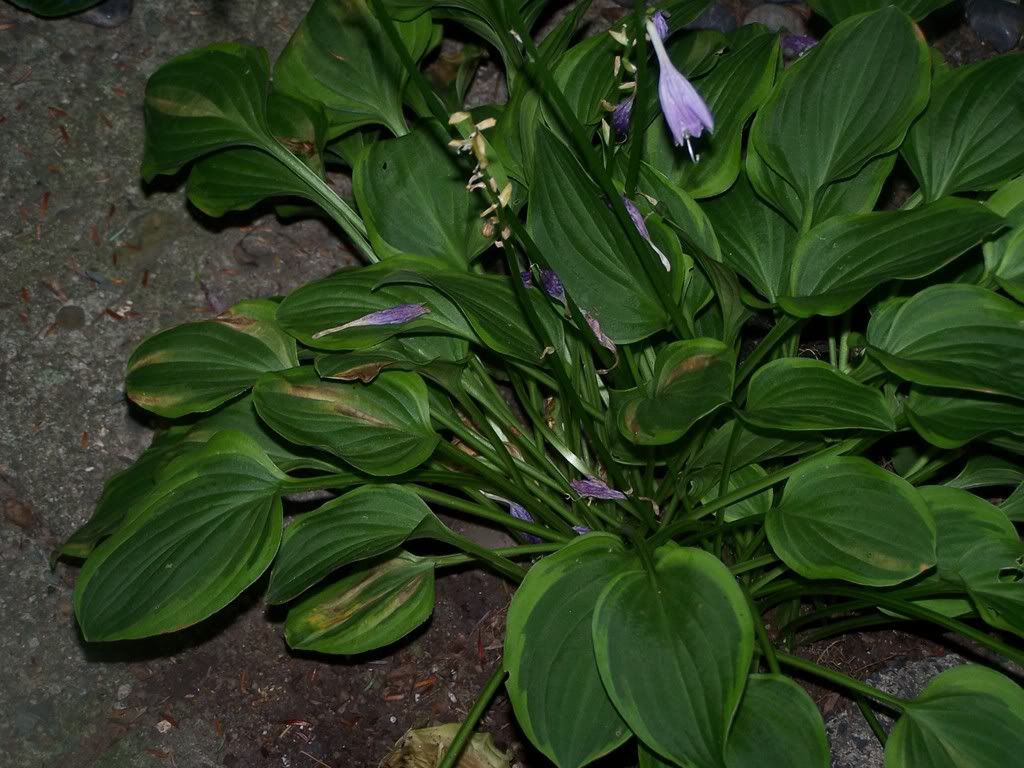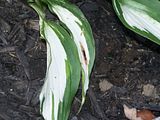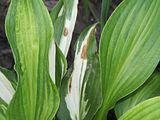Nematodes
Moderators: ViolaAnn, redcrx, Chris_W
- Quiet Storm
- Posts: 102
- Joined: May 17, 2006 7:35 am
- Location: Zone 6 -- Eastern Massachusetts
- Tigger
- Posts: 2727
- Joined: Oct 14, 2001 8:00 pm
- USDA Zone: 6b - 7a
- Location: SE Penna Zone 6b (7a?), lat. 39°50'
- Contact:
Sigh. My turn?
This Sultana has never thrived. We moved it from up near the porch into one of the new raised beds last year. Luckily it's small and not touching anyone, but the Fire and Ice that went pretty close to its previous living space is also looking suspicious.
So I took the worst leaves, tore them into a couple of pieces, and put them in a test tube with clean water. I have a bright spotlight (on a gooseneck via fiber optics) for illumination, and bought myself a 4x magnifier (along with reading glasses LOL). But after various periods of time, I see nothing. (I use a microscope in my job, so I'm used to this close-up work.) Am I not looking the right way? Do these things wriggle out of the torn edge or stem end? Are they light or dark colored? Or is this not nematodes?
This Sultana has never thrived. We moved it from up near the porch into one of the new raised beds last year. Luckily it's small and not touching anyone, but the Fire and Ice that went pretty close to its previous living space is also looking suspicious.
So I took the worst leaves, tore them into a couple of pieces, and put them in a test tube with clean water. I have a bright spotlight (on a gooseneck via fiber optics) for illumination, and bought myself a 4x magnifier (along with reading glasses LOL). But after various periods of time, I see nothing. (I use a microscope in my job, so I'm used to this close-up work.) Am I not looking the right way? Do these things wriggle out of the torn edge or stem end? Are they light or dark colored? Or is this not nematodes?
- Attachments
-
- Sultana plant
- DSCN2424.JPG (53.49 KiB) Viewed 4322 times
-
- Sultana leaf
- DSCN2425.JPG (18.52 KiB) Viewed 4318 times
I say dig it and treat it! Pot up and quarantine.
A chance to cook is a chance to cure! (Surgeon's mantra = cut instead of cook) Sultana is one of my favorites so that influences me.
I can't see them without a microscope myself.
The ones I have seen, don't wiggle fast, but they do move like earthworms. In the torn edges of the leaf where it transitions from healthy to unhealthy, you can find a few moving about. They appear transparent.
The ones people see with the hand lenses might be a different, larger species (conjecture)
I found three plants so far, one is a seedling in a pot so they either picked them up on the farm or from touching a neighbor in their pots last year.
A chance to cook is a chance to cure! (Surgeon's mantra = cut instead of cook) Sultana is one of my favorites so that influences me.
I can't see them without a microscope myself.
The ones I have seen, don't wiggle fast, but they do move like earthworms. In the torn edges of the leaf where it transitions from healthy to unhealthy, you can find a few moving about. They appear transparent.
The ones people see with the hand lenses might be a different, larger species (conjecture)
I found three plants so far, one is a seedling in a pot so they either picked them up on the farm or from touching a neighbor in their pots last year.
Dave
Dave's Hosta List
Dave's Hosta List
I soak a chopped up leaf overnight, then use a 10X hand held magnifying glass with bright sun as background light. The nems appear as tiny threads wiggling in the water. As a control, I've checked plain water at the same time to make sure what I'm seeing is not impurities in the water.
Today I'm placing a potted hosta in my closed van to bake all day in the sun. The heat inside should be way over their tolerance limits. Color me lazy.
Today I'm placing a potted hosta in my closed van to bake all day in the sun. The heat inside should be way over their tolerance limits. Color me lazy.
My question: does it seem like only specific cultivars are very susceptible to nematodes? From what I've been reading here, it seems that they target a particular hosta, but not necessarily the neighboring hosta plants. Someone else mentioned earlier (and I cannot find it now) that he thought nematodes were almost always present in nearly all soils. Have people seen this sort of damage by this time of the season, for years, but only now has it been more popularly known as nematode damage? Perhaps the stress of the weird weather has compromised the plant immune systems?
It is sad that the 'perfect perennial' must be closely watched for not only hvx, but now examined for nematodes... [and now daylilies have the rust issue...]
It is sad that the 'perfect perennial' must be closely watched for not only hvx, but now examined for nematodes... [and now daylilies have the rust issue...]
- VThosta/daylilylover
- Posts: 353
- Joined: Jun 25, 2007 3:38 pm
- Location: Vermont
- Quiet Storm
- Posts: 102
- Joined: May 17, 2006 7:35 am
- Location: Zone 6 -- Eastern Massachusetts
more nematodes?
My Golden Tiara, which I just divided and shared a couple of weeks ago, is now looking like this:
<center>


</center>
It looked fine two weeks ago, then all of a sudden, this. Nematodes? If memory serves correctly, this Golden Tiara has always (thought) gone dormant much earlier than my other hostas -- i.e., its leaves have turned brown and died off mid to late August each year. Could it have had nematodes all these years, and I just didn't know it?I am going to contact the two people with whom I shared the divisions and tell them to quarantine or get rid of the plants. Mine is not touching any other hostas, but is very near my Inniswood, Halcyon, and Krossa Regal.
<center>


</center>
It looked fine two weeks ago, then all of a sudden, this. Nematodes? If memory serves correctly, this Golden Tiara has always (thought) gone dormant much earlier than my other hostas -- i.e., its leaves have turned brown and died off mid to late August each year. Could it have had nematodes all these years, and I just didn't know it?I am going to contact the two people with whom I shared the divisions and tell them to quarantine or get rid of the plants. Mine is not touching any other hostas, but is very near my Inniswood, Halcyon, and Krossa Regal.
- HostaDesigner
- Posts: 750
- Joined: May 15, 2006 3:29 pm
- Location: Niles, MI
Re: more nematodes?
Yes, this is nematodes. Chances are, they have already spread to the nearby hostas as well, especially if they've been there for years. They'll spread by splashing water from sprinklers or rain, so even if a another hosta isn't touching, they'll get them too.Quiet Storm wrote:My Golden Tiara, which I just divided and shared a couple of weeks ago, is now looking like this:
It looked fine two weeks ago, then all of a sudden, this. Nematodes? If memory serves correctly, this Golden Tiara has always (thought) gone dormant much earlier than my other hostas -- i.e., its leaves have turned brown and died off mid to late August each year. Could it have had nematodes all these years, and I just didn't know it?I am going to contact the two people with whom I shared the divisions and tell them to quarantine or get rid of the plants. Mine is not touching any other hostas, but is very near my Inniswood, Halcyon, and Krossa Regal.
Personally. I'd dig out all nearby plants and burn them. Then, I'd pour a million gallons of boiling water in the planting areas to kill any in/on the ground.
- Quiet Storm
- Posts: 102
- Joined: May 17, 2006 7:35 am
- Location: Zone 6 -- Eastern Massachusetts
Another nematode question
After nematode infested hostas have been heat treated and potted up, what do you do with them for the winter? Can they be left outdoors in the pots, or do they need to be moved inside, e.g., to an unheated garage or shed. I have some hostas (undulatas) that I grow in pots, and I just leave them outside all winter, with no apparent ill effects, but not sure what to do with those that have been heat treated to get rid of nematodes.
-
eastwood2007
- Posts: 3517
- Joined: Jan 25, 2007 12:51 pm
- Location: kansas, usa zone 5b
Good question, QS.
I have another...
We know that nematodes can live thru the winter in the crowns of hostas, but can they live thru the winter just in the surrounding soil?
I wonder if you treated the plant thru the summer with disulfoton, so the nems in the plant would be dead, would the winter kill them in the soil?
I have another...
We know that nematodes can live thru the winter in the crowns of hostas, but can they live thru the winter just in the surrounding soil?
I wonder if you treated the plant thru the summer with disulfoton, so the nems in the plant would be dead, would the winter kill them in the soil?
Charla
Latitude 38.57N; Longitude -94.89W (Elev. 886 ft.)
Latitude 38.57N; Longitude -94.89W (Elev. 886 ft.)
- Chris_W
- Administrator
- Posts: 8465
- Joined: Oct 05, 2001 8:00 pm
- USDA Zone: 9
- Location: Co. Roscommon, Ireland
- Contact:
Hi there. I've read up on nematodes quite a bit, both in the past and more recently, and here is some info that seems to be in the consensus of the articles.
Foliar nematodes, like in hostas, are present almost exclusively in the leaves and crown and only in the soil or surrounding area in leaf clutter and possibly weeds. But there are quite a few other bad nematodes that do live in soil. According to some research, a small number of foliar nematodes may be able to live or stay dormant in the soil, however the number is really low.
Disyston and Zerotol will kill adult and juvenile nematodes, but not all of them and it will not kill the eggs. Nematodes have about a 2 week life cycle so you would need to treat repeatedly and won't ever get them all. However these chemicals can help to suppress the symptoms.
Hot weather, especially in areas of the south, will naturally heat treat plants. It may not be hot enough to kill all of them but will also suppress symptoms. Winters in the north will also kill adults and if that is combined with short summers the season might not be long enough to ever see symptoms before they get frozen in fall. Zones 3/4 can be like this - nematodes can be there and never show up.
Dry summers will also suppress the nematode population - wet summers will increase it.
Growing hostas in the sun will suppress nematode symptoms.
Personally I would strongly recommend heat treating plants (and the surrounding plants) which have nematodes. If you start throwing plants away you will likely throw your whole collection away in time. Unfortunately it is that tough to keep them out of the garden.
Once the plants are heat treated you could pot them up or put them out in the garden again in a different spot.
As a nursery we work hard to keep nematodes out and work really hard to eliminate any that get in but it tough. It would be nearly impossible for any nursery to 100% guarantee nematode free plants but unfortunately other sellers and wholesalers figure it is a losing battle so don't even bother trying.
I hope that helps to clear a few things up. I would hate to have everyone throw away all of their plants when they really can be treated.
Chris
Foliar nematodes, like in hostas, are present almost exclusively in the leaves and crown and only in the soil or surrounding area in leaf clutter and possibly weeds. But there are quite a few other bad nematodes that do live in soil. According to some research, a small number of foliar nematodes may be able to live or stay dormant in the soil, however the number is really low.
Disyston and Zerotol will kill adult and juvenile nematodes, but not all of them and it will not kill the eggs. Nematodes have about a 2 week life cycle so you would need to treat repeatedly and won't ever get them all. However these chemicals can help to suppress the symptoms.
Hot weather, especially in areas of the south, will naturally heat treat plants. It may not be hot enough to kill all of them but will also suppress symptoms. Winters in the north will also kill adults and if that is combined with short summers the season might not be long enough to ever see symptoms before they get frozen in fall. Zones 3/4 can be like this - nematodes can be there and never show up.
Dry summers will also suppress the nematode population - wet summers will increase it.
Growing hostas in the sun will suppress nematode symptoms.
Personally I would strongly recommend heat treating plants (and the surrounding plants) which have nematodes. If you start throwing plants away you will likely throw your whole collection away in time. Unfortunately it is that tough to keep them out of the garden.
Once the plants are heat treated you could pot them up or put them out in the garden again in a different spot.
As a nursery we work hard to keep nematodes out and work really hard to eliminate any that get in but it tough. It would be nearly impossible for any nursery to 100% guarantee nematode free plants but unfortunately other sellers and wholesalers figure it is a losing battle so don't even bother trying.
I hope that helps to clear a few things up. I would hate to have everyone throw away all of their plants when they really can be treated.
Chris
Last edited by Chris_W on Jun 29, 2008 10:26 am, edited 1 time in total.

- Quiet Storm
- Posts: 102
- Joined: May 17, 2006 7:35 am
- Location: Zone 6 -- Eastern Massachusetts
Thanks Chris.
I couldn't quite bring myself to destroy all the surrounding plants. In addition to heat treating some of them by soaking them in hot water, I plan to try digging some and leaving them in the car on a very hot day. I also plan to treat them all with disyston as an added measure. I planted my new acquisitions well away from the area that seems to be having the most trouble, so hopefully they are safe for now, although I've noticed some nearby lilies of the valley that are dying back in the area where I planted the newbies. Don't know what nematode damage on lily of the valley looks like, but I sure hope that's not what it is.
I couldn't quite bring myself to destroy all the surrounding plants. In addition to heat treating some of them by soaking them in hot water, I plan to try digging some and leaving them in the car on a very hot day. I also plan to treat them all with disyston as an added measure. I planted my new acquisitions well away from the area that seems to be having the most trouble, so hopefully they are safe for now, although I've noticed some nearby lilies of the valley that are dying back in the area where I planted the newbies. Don't know what nematode damage on lily of the valley looks like, but I sure hope that's not what it is.
Nematodes
If I find a plant that is suspect I use the hot water method, 120 degrees for 10 minutes and repot them right after. So far I have never had them return to the same plant I treated or have they resurfaced in areas where I poured boiling water in the hole.
Granted the plant takes quite a while to recover but eventually does just fine.
In the last 4 years I have only had to treat 5 or 6 hostas this way. Three of them came from the same ebay vendor and I wish I had potted and let them sit till august before planting them. Live and learn.
With only 5 or 6 of my hundreds of plants affected it is fairly easy to contain and stay on top of the problem.
Granted the plant takes quite a while to recover but eventually does just fine.
In the last 4 years I have only had to treat 5 or 6 hostas this way. Three of them came from the same ebay vendor and I wish I had potted and let them sit till august before planting them. Live and learn.
With only 5 or 6 of my hundreds of plants affected it is fairly easy to contain and stay on top of the problem.
- Quiet Storm
- Posts: 102
- Joined: May 17, 2006 7:35 am
- Location: Zone 6 -- Eastern Massachusetts
-
eastwood2007
- Posts: 3517
- Joined: Jan 25, 2007 12:51 pm
- Location: kansas, usa zone 5b

